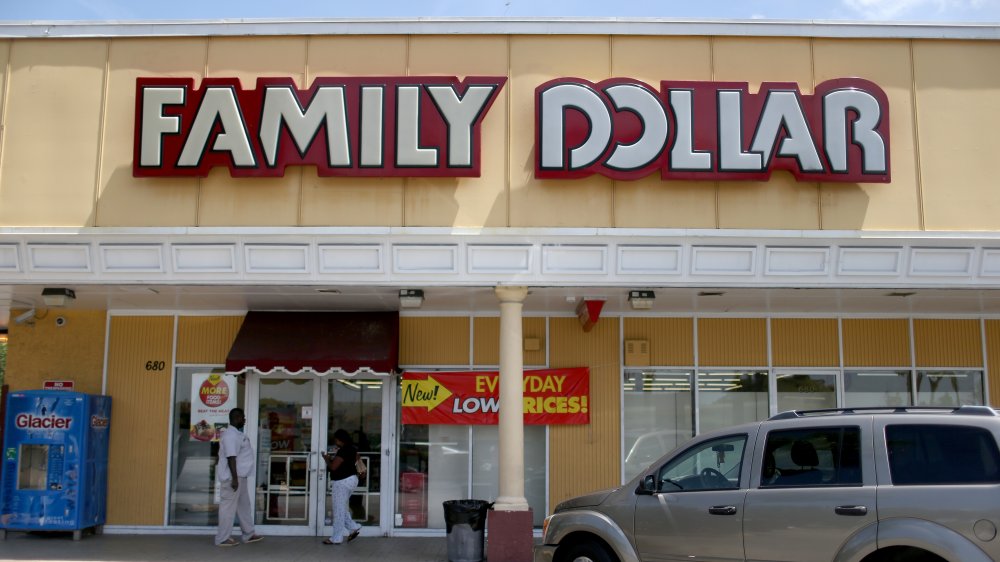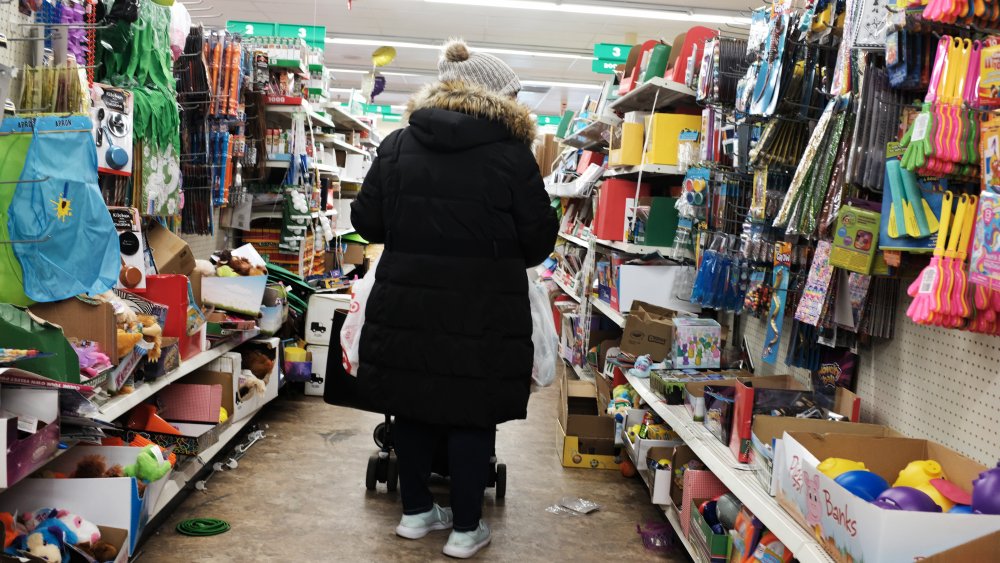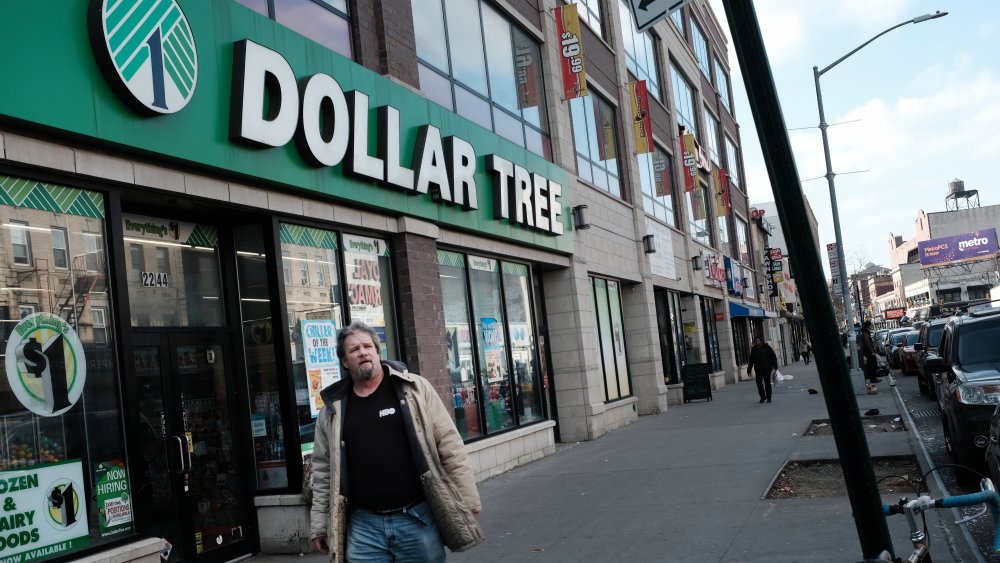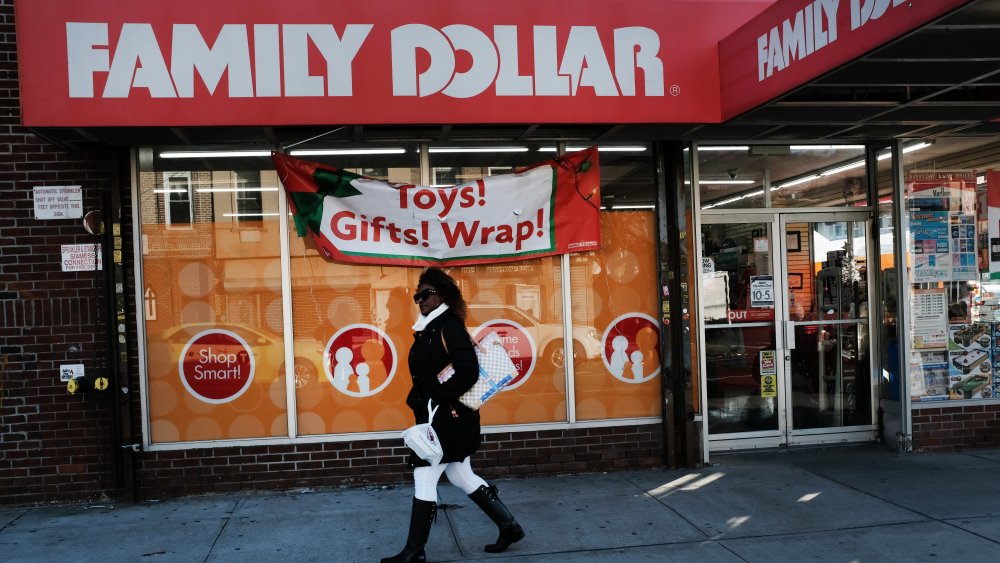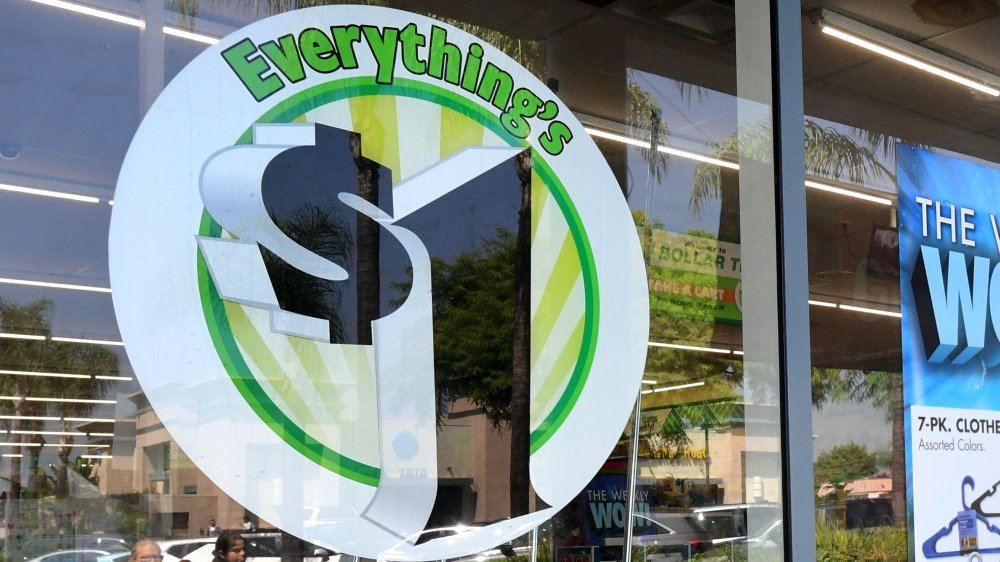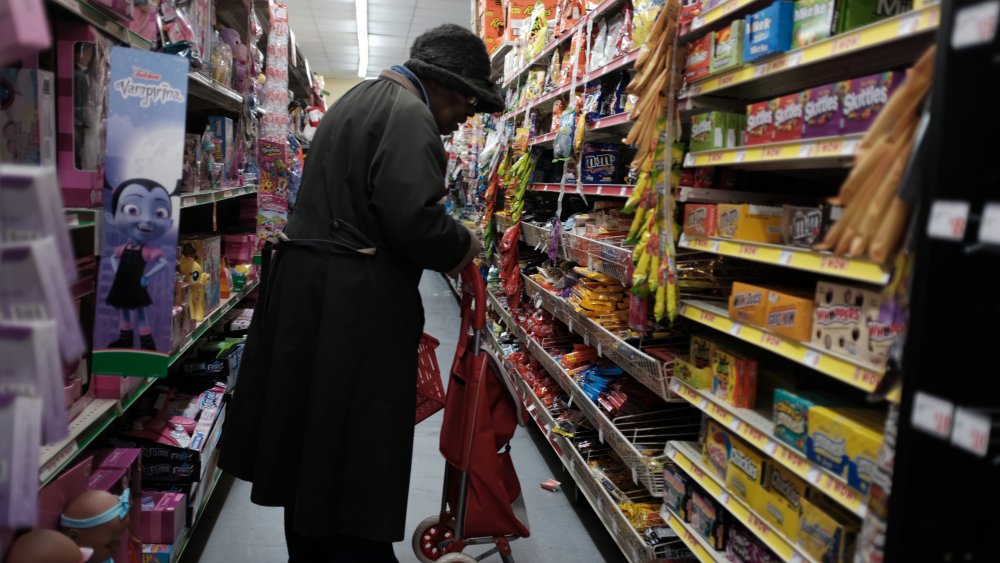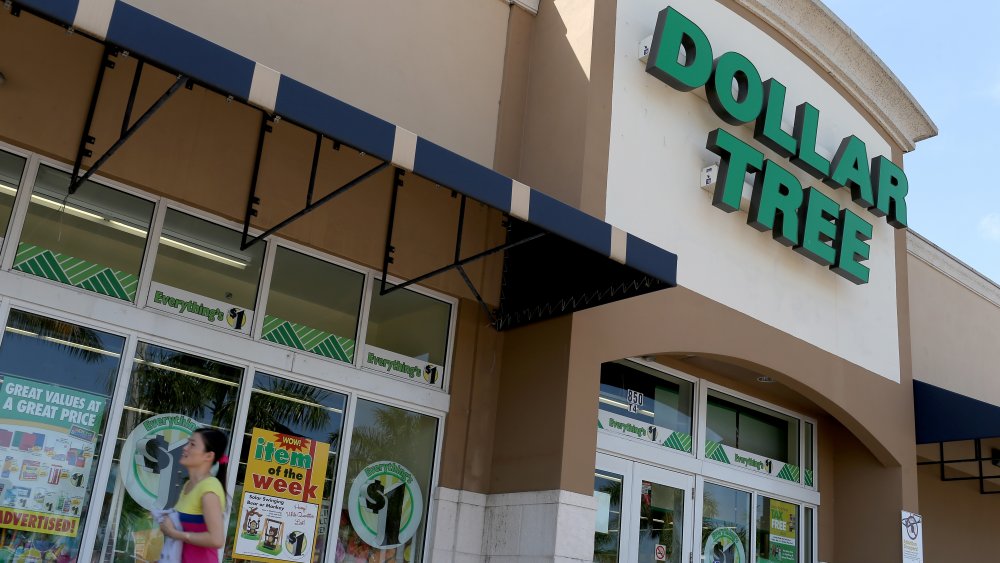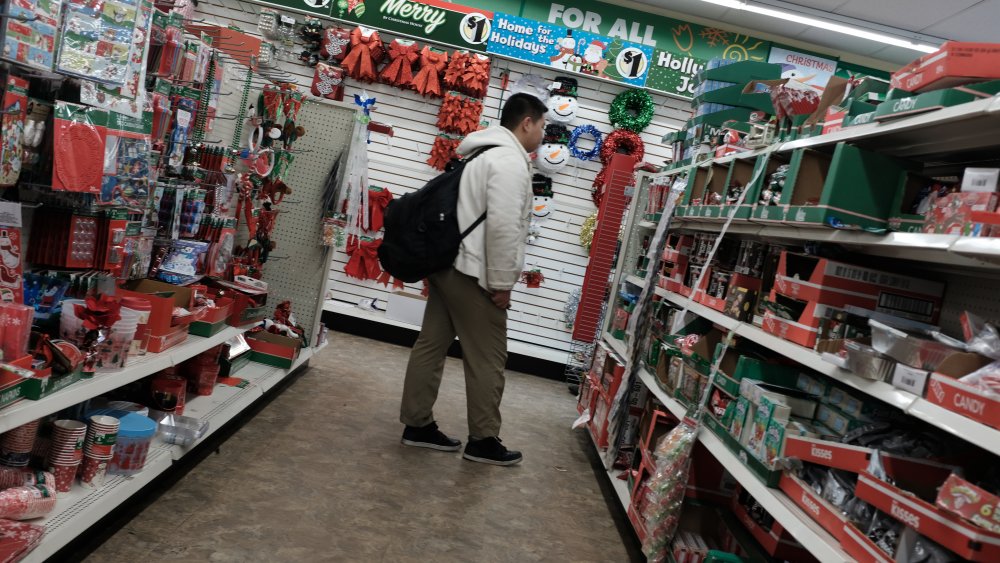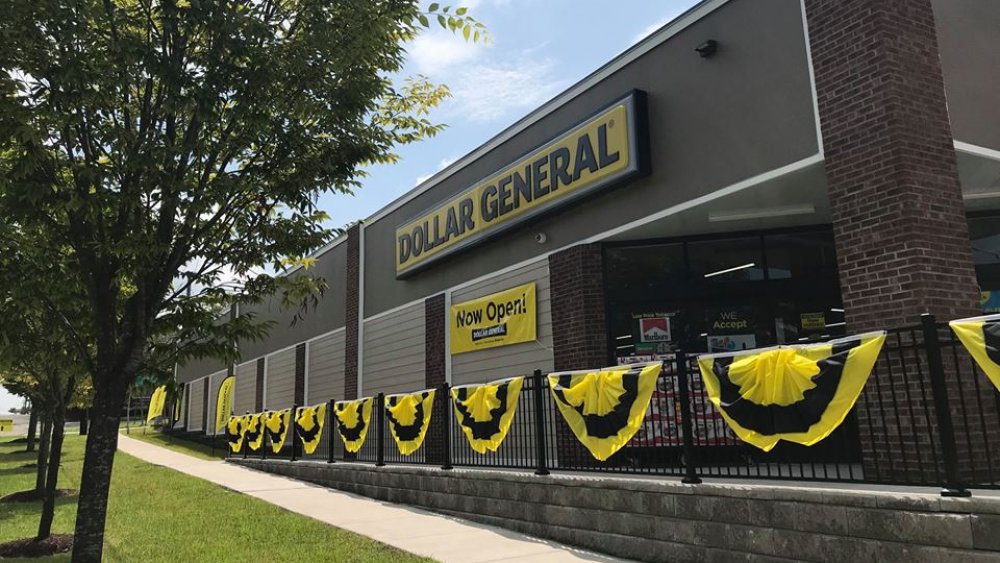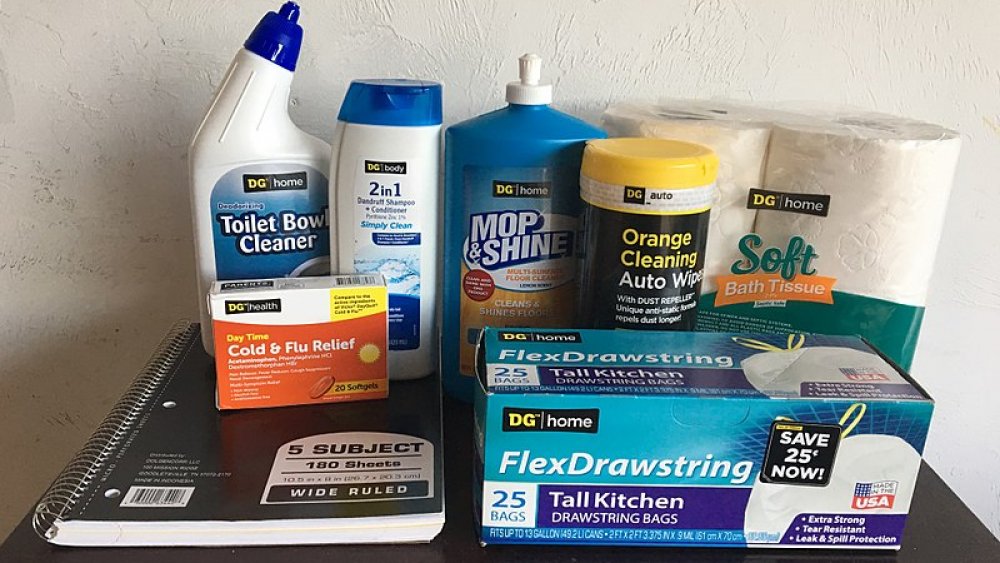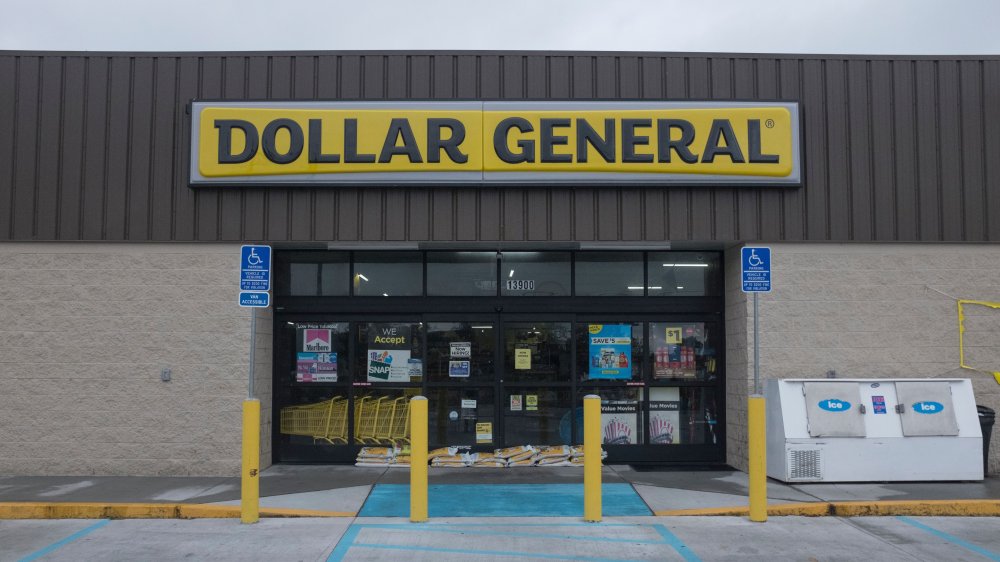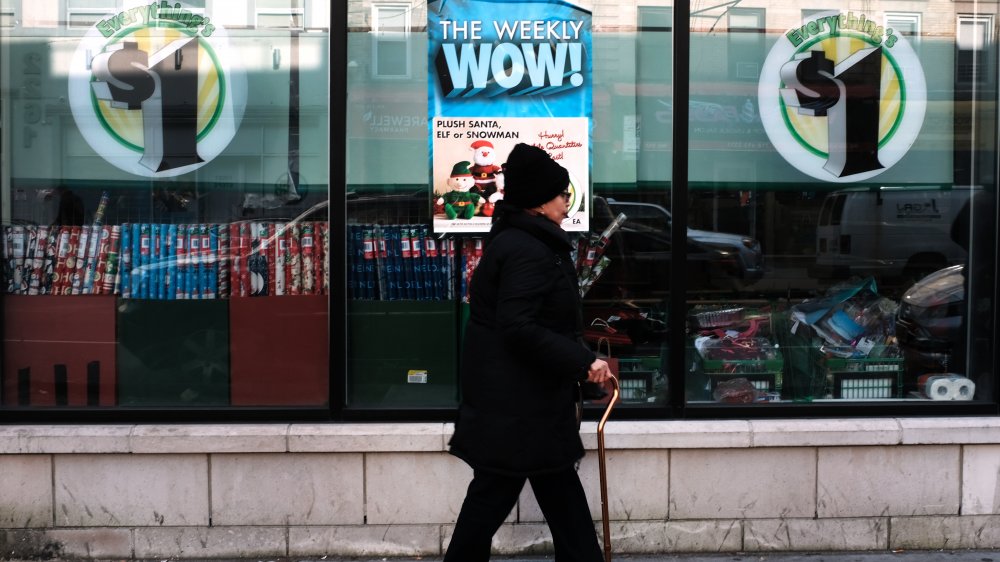How Dollar Stores Really Make Their Money
There is no store more convenient than a dollar store. Even people who don't have much money can go into a dollar store and find everything from toiletries to canned foods to children's toys and school supplies, all for a dollar or less (with a few exceptions at the still-super-cheap Dollar General chain). It's quicker than a trip to the grocery store, gives you more options than a convenience store, and it's seemingly much cheaper than both.
Both Dollar General and Dollar Tree, the two largest dollar store chains in the country, each had around 15,000 store locations in the United States in 2018, and that number has only been growing since — as have sales. In the first six months of 2019, Dollar Tree (which also owns Family Dollar as of 2015) saw an increase of $12.2 million in gross profits, earning $3.38 billion. Dollar General saw the same kind of results, earning an annual revenue of $25.62 billion in 2019 alone. Every year these stores see higher and higher earnings, but how can a store that seems like it is basically giving things away possibly turn itself into a multi-billion-dollar enterprise? The answer is simple: that dollar isn't always the great deal it appears to be. This is how dollar stores really make their money.
Convenience is key at dollar stores
In America, it might seem like the economy is always going up and going down, as are things like the unemployment rate. High or low, though, you can still count on people to flock to dollar stores because they have the one thing everyone loves: convenience. Sales for Dollar General are always on the upswing, with the chain seeing an increase of 3.7 percent between 2017 and 2018 regardless of the state of the economy. Even though the unemployment rate fell to less than four percent, "We have seen no sign of trade out or trade up from our core customers," said chief executive of Dollar General, Todd Vasos. "Even in a good economy, [they are] still looking for value and convenience."
So, basically, no matter how much money people have, they still want something that bigger grocery stores can't give them. Dollar stores are not just convenient because their items are cheaper, but also because there seems to be one on every corner (especially in the lower-income parts of town) making them perfect for a quick fill-in trip between your weekly grocery runs. These stores are also typically smaller than the ones in a big chain like Walmart, which means that you can usually get in and out with your emergency bag of dog food or supplies for your kid's art project in just a couple of minutes. The fact that most people are on to this, means dollar stores are always making money.
The location of dollar stores keep the money rolling in
It's common knowledge that the success of a business is largely based on its location. If you aren't in a place where you can offer something that the local community needs, you aren't going to have much of a clientele. This is why Dollar Tree and Dollar General are mostly located in areas where people with a lower income level reside, and/or in which big box stores aren't easily accessible.
According to CNN Business, 75 percent of Dollar General stores are located in towns that have less than 20,000 people. The chain targets sparsely populated rural areas where it can be the only game in town when it comes to buying food or other supplies. In most cases, the closest grocery store is more than 15 or 20 miles away, making the dollar store a much more convenient option.
Dollar General also strives to put locations in areas that are known as "food deserts." These areas — which aren't just limited to rural towns, but may also include underserved urban areas — are places in which fresh food is not readily available. To take advantage of this, dollar stores offer snacks and are even working to expand their fresh food sections, giving people even more reason to shop there. More customers means more dollars, and those dollars soon add up to big bucks.
Dollar stores target low-income customers
It is no secret that a store that sells most items for $1 was made in the interest of appealing to customers who don't have a ton of money. According to Babson Centennial, the families of most dollar store shoppers make less than $50,000 per year, which makes them "much more price-sensitive" than wealthier people. These shoppers don't just want a better deal than they can find at other stores, they need one.
Dollar stores capitalize on this need by opening stores in lower-income areas and presenting themselves as a cheaper and more convenient option. If you don't have to drive half an hour to get to a full-size grocery store, you don't spend as much money on gas, which helps to save a lot of money in the long run. The savings only continue when you arrive at the store and find thousands of items offered at a much lower price point than competitors.
For this reason, dollar stores quickly began to beat out even the great and powerful Walmart chain when it came to sales, prompting Walmart to attempt to compete by opening its own line of "small box stores" called Neighborhood Markets. Unfortunately for them, though, dollar stores still crushed these new, perhaps healthier alternatives, and have now very nearly taken over the entire grocery business in some parts of the U.S.
The prices at dollar stores aren't always a deal
It doesn't matter how rich or poor you are: a dollar for a bottle of shampoo sounds like an awesome deal. Before you start filling up your cart, though, there's something you should know. That dollar is not always as good a value as it seems.
According to a report published on AOL.com, "Just because a store has 'dollar' in its name doesn't mean it's less expensive than the competition. In fact, it's likely that you're paying more at a dollar store than you would at Walmart or Target for the same item." Stores like Dollar Tree and Dollar General count on the customer being distracted by the appearance of a discount and not taking the time to check the difference between the sizes and the quality of the items at their stores. Because of this, unsuspecting customers end up actually paying more for an item than they would have somewhere else, and it usually doesn't last nearly as long.
In reality, it is grocery stores that offer the highest discounts, although they see lower earnings overall. For every dollar spent by a customer at Dollar Tree, the company makes a profit of $0.35. Walmart, for example, makes only $0.24 per dollar. This is because the items at dollar stores cost less to manufacture, and the company isn't losing any money by keeping them on "sale" for just a dollar.
Smaller sizes give the illusion of a discount at dollar stores
The number one best trick carried out by dollar stores is that they are actually giving you less for your money. You might think you found a great deal by buying a box of aluminum foil for $1, but check the length of the roll. According to one of several analyses compiled by HowStuffWorks.com, the foil you buy at Dollar Tree is 15 feet long, while a $4.06 roll at Walmart contains 75 feet of foil (prices may vary by location) — meaning at Walmart you're getting over 18 feet per $1. The same applies to things like milk (you get a 16-ounce bottle for $1, which means you would have paid a whopping $8 for an entire gallon), raisins ($1 for a 4.5-ounce bag instead of 72 ounces for around $10.59 at a grocery store), and flour ($1 for two pounds instead of around $2 for five at another store).
As if this weren't bad enough, you should know that according to Macon Brock, one of the founders of Dollar Tree, dollar store owners are basically counting on people to not think so they don't notice what's going on behind the curtain. "When a customer walked into our store," he wrote in his book, "she could shut off her brain. She didn't have to think, didn't have to calculate how much she was spending. All she had to do was count – 'One, two, three, four, five, six. I have six items and I have six dollars. I can buy this.'"
Dollar stores sell cheaply made items
At a dollar store, you get what you pay for. While a dollar might be a deal for some items, you can't expect something long-lasting and high-quality if you can pay for it with loose change. Whether it's Dollar General, Dollar Tree, or any other chain of dollar stores, one of the biggest ways that the business saves money is by selling items that are made of cheap, flimsy materials.
According to the Washington Post, children's toys are one of the worst things you can buy at a dollar store. They are made with tiny pieces that come off and can be choked on, and they fall apart surprisingly quickly because they are made of parts that cost next to nothing to put together. Electronics and things like power strips are a bad idea too. After one use (or 20), they could malfunction and ruin your devices because they weren't made with the proper materials and safety standards.
Most people don't expect their dollar store purchases to last forever, and when one thing breaks, they just go back and get a replacement for another dollar, which means more money in the dollar store's pocket. Instead of buying a higher-quality item at another store for $5 once, they end up buying the same, cheaply made item ten times at Dollar Tree and spending twice as much without noticing, which is all part of the company's plan.
Dollar stores are strategically designed
If you've ever been inside a dollar store, you will have noticed that it's much smaller and more compact than a typical grocery store. This is no accident. According to Business Insider, a store Dollar Tree is usually small, with an average size of just 8,000 to 12,000 square feet. They say that's about one-eighteenth of the size of the average Walmart — so it's not just a small difference. The stores are designed this way so that you can easily go through the entire store in just a matter of minutes, making it more likely that you can find something you need or want without much searching.
There is also a method to the way the aisles are arranged that affects what shoppers buy. Typically, seasonal items like Christmas decorations, party favors, or summery cups and pinwheels meet you as soon as you walk in the door, tempting you with the stores' newest inventory right off the bat. The products that shoppers buy most frequently, such as food or children's toys, are placed in the back, meaning that you have to walk through the entire store — and past all the other tempting deals — to get to them. This set-up has been proven to sell more products because people leave with a lot more than what they came in to get.
Hiring fewer employees means less money going out at dollar stores
Another way that dollar stores can make so much money is that they don't have to spend much money. The average small, independent grocery store employs around 14 people, but the average Dollar Tree and Dollar General only employ eight. Dollar stores are typically smaller and don't see the huge rush that other retailers do, so they can afford to get by with only a handful of workers per shift. As a result, they don't have as many employees to pay and provide insurance and benefits for, so they don't see as much money going out as other stores do.
The downside to this is that most dollar stores are located in areas in which people are struggling economically. While the arrival of a new Walmart, Meijer, or Target in town could mean many more jobs for the locals, a new Dollar Tree really doesn't. So while the chain itself is saving money and raking in more and more of it, this money isn't being spread out into the community, which is one of the major complaints about this type of establishment.
Producing and selling private label items costs dollar stores less money
According to Business Insider, private labels are dollar stores' "secret weapon." Most big box stores offer private label products too, but this practice is especially lucrative for stores like Dollar General and Dollar Tree. A private label is usually one owned by the store, and its products can typically be identified as "store brand." Dollar General, for example, offers home goods branded as "DG Home" and over-the-counter medicines as "DG Health." The Dollar Tree disguises their private labels a bit more, choosing to go with company names like "Sassy + Chic" for makeup and "Supreme Tradition" spices.
These private label items cost less to manufacture, and therefore appear on the shelves with a price that is less than half of what name brands charge for the same item. At one point in time, this strategy didn't work, as people were loyal to specific brands because they knew they would get the quality they were looking for. As the economy shifted, though, and the quality of even brand name products changed, people began to grow more "apathetic" to brands. Now, thanks in part to millennials making up a large portion of the shopping public, people are less focused on which brand is best and are more focused on things like price and environmental impact, meaning that private labels, generics, and unknown brands have quickly become the most appealing options. When people are buying their store brands, dollar stores are raking in a lot more profit.
Dollar stores are squeezing out grocery stores (and getting paid to do it)
Over the past eight years, dollar stores have seen explosive growth across the United States, and show no signs of slowing down. Part of the reason that this is happening — and that these companies bring in so much money per year — is that dollar stores are pushing out grocery stores, especially locally owned ones. Small grocery stores just can't compete with the low prices and the ultra-convenience of a dollar store, so they often find that they are losing customers to this thrifty competitor.
While this is bad in and of itself, there is more to the story. Not only are dollar stores purposely squeezing out independent and locally owned grocery stores (full of healthier food choices and actual better deals), but they are getting paid by the government to do it. In 2016, Dollar General received around $1 million in incentives through the National Grid programs and around $750,000 from New York's "small cities grant program." They also received breaks on both sales and property taxes to the tune of more than $10 million, all in an effort to keep the stores thriving and expanding in the state. The hope behind this is that more Dollar General stores will mean more jobs for locals and a boost to the economy so that more people will move to the area, even if it means the loss of grocery stores and other local businesses.
Dollar stores are causing "economic distress"
Above all, the main way that dollar stores make money is that they offer a way for low-income people to get the everyday items they need for an affordable price. For this reason, the large majority of dollar stores are located in areas that see a lot of "economic distress." Unfortunately, dollar stores don't really help to fight economic distress — they cause more of it.
According to Fast Company, dollar stores deliberately target "some of the country's most vulnerable communities," including rural areas, largely black neighborhoods, small towns, and urban areas. Once they set up shop, they wipe out all competition in the form of grocery stores and independent small businesses, making them the only choice when it comes to food and other necessities. While the dollar store itself makes millions off these communities, the people in them are left with no healthy food options and no locally owned businesses, resulting in even less income for the already-stressed economic environment. In the words of Marie Donahue and Stacey Mitchell of the Institute for Local Self-Reliance, "Although dollar stores sometimes fill a need in places that lack basic retail services, there's growing evidence that these stores are not merely a byproduct of economic distress. They're a cause of it."
Dollar stores make money because they offer something people think they can't get anywhere else and because of this, they are taking much more than people's dollars.
